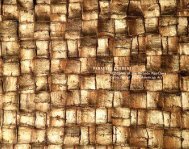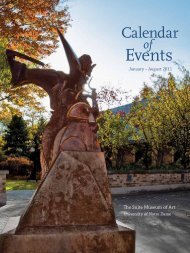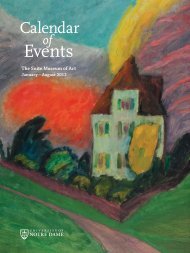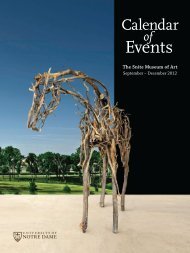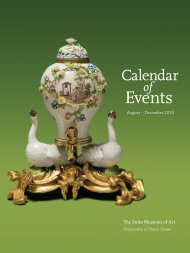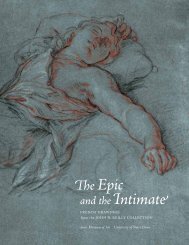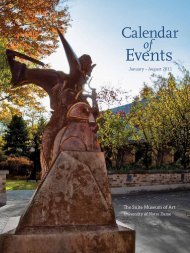HISTORY INTO ART AND ANTHROPOLOGY - Snite Museum of Art ...
HISTORY INTO ART AND ANTHROPOLOGY - Snite Museum of Art ...
HISTORY INTO ART AND ANTHROPOLOGY - Snite Museum of Art ...
Create successful ePaper yourself
Turn your PDF publications into a flip-book with our unique Google optimized e-Paper software.
FOREWARD<br />
JOANNE M. MACK<br />
For slightly more than a decade during the late nineteenth century, Father Eli<br />
Washington John Lindesmith served as the first Catholic chaplain ever commissioned<br />
in the U.S. Army during peacetime. 1 Assigned to Fort Keogh, Montana Territory,<br />
he interacted daily and directly with infantry, cavalry, and Native American scouts—<br />
primarily Cheyenne. He also traveled to important historic and natural-history sites.<br />
Over time, he amassed a collection <strong>of</strong> objects that can be divided into six major<br />
categories: military, Montana history, Native American ethnohistory, natural history,<br />
personal, and religious. Father Lindesmith’s collection provides unique snapshots <strong>of</strong><br />
the Northern Plains during the 1880s; this exhibition and accompanying catalogue<br />
highlight some <strong>of</strong> its most beautiful Native American works.<br />
Outstanding among the items in the collection are the singular examples <strong>of</strong> beadwork<br />
produced by the wives and sisters <strong>of</strong> Cheyenne scouts who, with their families, lived<br />
at Fort Keogh. Lindesmith also purchased objects at the Crow Agency near the Little<br />
Big Horn battlefield, which he visited twice while stationed at the fort. During his<br />
eleven years there, he traveled west to St. Ignatius Mission on the Flathead Reservation<br />
and from there into the Pacific Northwest. In addition, during one furlough<br />
he went to upstate New York and Minnesota and on to Virginia, Pennsylvania, and<br />
Washington, D.C. 2 On his travels, he purchased or received as gifts Native American<br />
objects that he considered historically important and that also have artistic merit. The<br />
part <strong>of</strong> his collection exhibited and catalogued here also includes Native American<br />
objects he had either found or was given before arriving in Montana.<br />
From the standpoint <strong>of</strong> art history, anthropology, and American history, a remarkable<br />
feature <strong>of</strong> the collection is Father Lindesmith’s superb record keeping. For almost<br />
every object he obtained, Lindesmith described the circumstances surrounding its<br />
acquisition. If, for example, he bought an item, he duly noted exactly when and<br />
for how much, and he <strong>of</strong>ten assessed what he considered its historical value. His<br />
meticulous documentation includes account books, diaries, letters received and sent,<br />
memoranda, sermons, and other written records.<br />
Accompanying every object he donated in the late 1890s to several educational<br />
institutions was a handwritten tag containing relevant facts. Unfortunately, among<br />
them these institutions lost a great number <strong>of</strong> the original tags and some <strong>of</strong> the<br />
14 15



